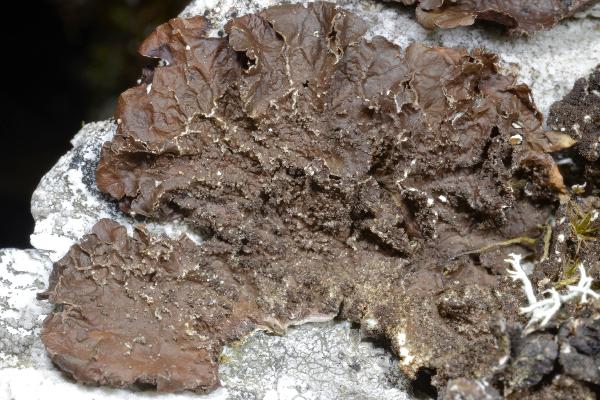Nephroma orvoi Timdal, M. Westb., Haugan, Hofton, Holien, Speed, Tønsberg & Bendiksby
Graphis Scripta, 32, 4: 78, 2020
Synonyms:
Distribution:
Description: Thallus foliose, heteromerous and dorsiventral, loosely adnate, fragmentary or forming 4-10(-13) cm wide rosettes. Lobes irregular, 10-15 mm wide, elongate, thin, subrotund at apices, with entire or dissected, rarely ascending margins. Upper surface smooth to distinctly foveolate especially near the lobe ends medium brown to dark brown or partly olivaceous brown, with mostly laminal, more rarely marginal, soralia which are often concentrated on the ridges; soredia granular, long remaining corticate, sometimes forming coralloid clusters; lower side medium brown near the lobe ends, darker brown to blackish brown in inner part, smooth, naked or pseudotomentose near the lobe ends, always pseudotomentose in middle and inner part. Upper and lower cortex paraplectenchymatous; medulla white. Apothecia and pycnidia not known. Photobiont cyanobacterial (Nostoc, the cells not in long chains). Spot tests: cortex and medulla K-, C-, KC-, P-. Chemistry: upper cortex with an unknown brown pigment; medulla with a series of hopane triterpenoids, mainly compounds T1 (7β-acetoxyhopan-22-ol; peltidactylin), T3 (hopane-6α,22-diol; zeorin), T4 (hopane-7β,22-diol, the major compound), and T6 (hopane 6α,7β,22-triol), with traces of additional unknown terpenoids.Note: a recently-described, semi-cryptic species, hardly distinguishable morphologically from N. parile, but chemically different, known from Fennoscandia, Switzerland, North America and Greenland (Timdal & al. 2020). It grows both on brk and on base-rich siliceous rocks, within Lobarion-communities. Its presence in Switzerland suggests that it should be looked for also in the Italian Alps.
Growth form: Foliose, broad lobed
Substrata: bark and rocks
Photobiont: cyanobacteria, filamentous (e.g. Nostoc, Scytonema)
Reproductive strategy: mainly asexual, by soredia, or soredia-like structures (e.g. blastidia)
Most common in areas with a humid-warm climate (e.g. most of Tyrrenian Italy)
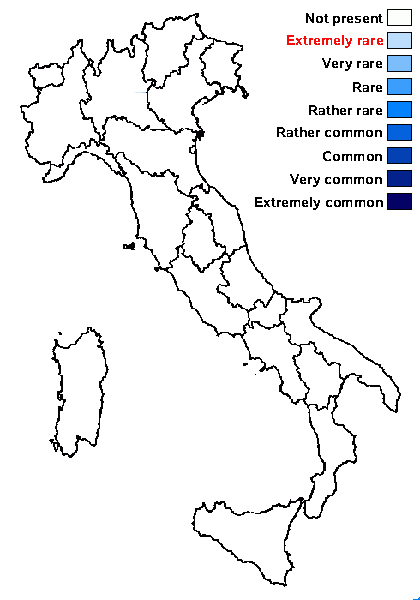
Predictive model
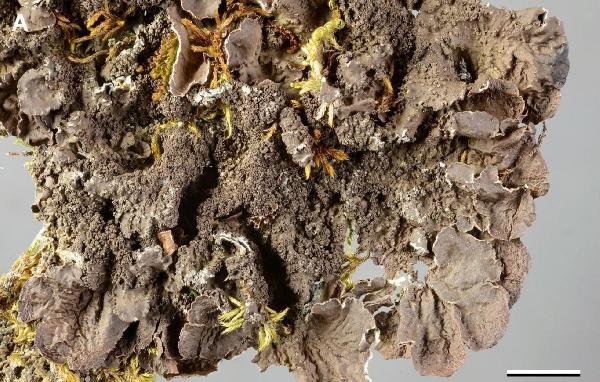
Source: Timdal, E., Westberg, M., Haugan, R., Hofton, T. H., Holien, H., Speed, J. D. M., Tønsberg, T. & Bendiksby, M. 2020. Integrative taxonomy reveals a new species, Nephroma orvoi, in the N. parile species complex (lichenized Ascomycota). Graphis Scripta 32 (4): 70–85. Oslo. ISSN 2002-4495. - CC BY-4.0
Holotype (O L-195875). Scale: 5 mm
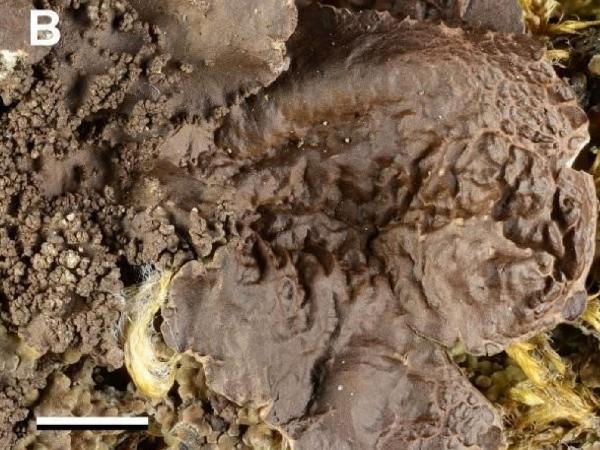
Source: Timdal, E., Westberg, M., Haugan, R., Hofton, T. H., Holien, H., Speed, J. D. M., Tønsberg, T. & Bendiksby, M. 2020. Integrative taxonomy reveals a new species, Nephroma orvoi, in the N. parile species complex (lichenized Ascomycota). Graphis Scripta 32 (4): 70–85. Oslo. ISSN 2002-4495. - CC BY-4.0
Holotype (O L-195875). Scale: 2 mm
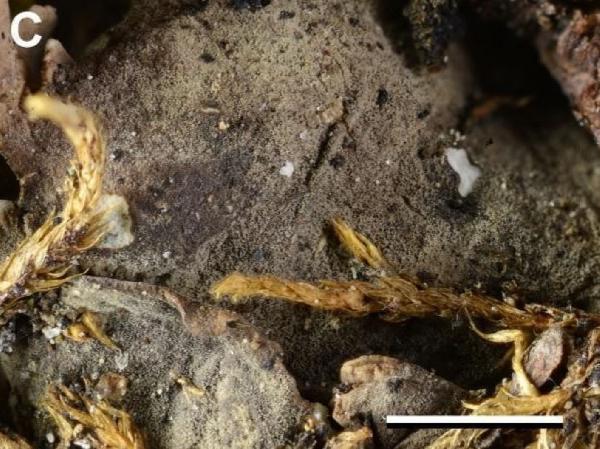
Source: Timdal, E., Westberg, M., Haugan, R., Hofton, T. H., Holien, H., Speed, J. D. M., Tønsberg, T. & Bendiksby, M. 2020. Integrative taxonomy reveals a new species, Nephroma orvoi, in the N. parile species complex (lichenized Ascomycota). Graphis Scripta 32 (4): 70–85. Oslo. ISSN 2002-4495. - CC BY-4.0
Holotype (O L-195875). Scale: 2 mm
Growth form: Foliose, broad lobed
Substrata: bark and rocks
Photobiont: cyanobacteria, filamentous (e.g. Nostoc, Scytonema)
Reproductive strategy: mainly asexual, by soredia, or soredia-like structures (e.g. blastidia)
Most common in areas with a humid-warm climate (e.g. most of Tyrrenian Italy)

Predictive model

Source: Timdal, E., Westberg, M., Haugan, R., Hofton, T. H., Holien, H., Speed, J. D. M., Tønsberg, T. & Bendiksby, M. 2020. Integrative taxonomy reveals a new species, Nephroma orvoi, in the N. parile species complex (lichenized Ascomycota). Graphis Scripta 32 (4): 70–85. Oslo. ISSN 2002-4495. - CC BY-4.0
Holotype (O L-195875). Scale: 5 mm

Source: Timdal, E., Westberg, M., Haugan, R., Hofton, T. H., Holien, H., Speed, J. D. M., Tønsberg, T. & Bendiksby, M. 2020. Integrative taxonomy reveals a new species, Nephroma orvoi, in the N. parile species complex (lichenized Ascomycota). Graphis Scripta 32 (4): 70–85. Oslo. ISSN 2002-4495. - CC BY-4.0
Holotype (O L-195875). Scale: 2 mm

